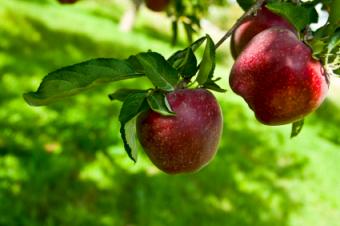
Planting apple trees correctly gives young trees an advantage. Trees will grow stronger, taller, and bear more fruit. From selecting the proper varieties for pollination to soil amendments, planting apple trees requires a bit of planning for success.
Tips for Planting Apple Trees
While you can plant apple trees and other fruit trees in the fall or spring, most experts recommend fall planting. The cooler temperatures yet warm soil minimize transplant shock, and provide trees with several weeks of optimal growing conditions so that they can establish a strong root system before going dormant in the winter months. When spring warmth edges out winter temperatures, the apple trees will be ready to grow again.
Look for a location for your apple orchard that receives full sunlight for at least six hours a day. Morning sunlight is ideal, as it will dry the leaves and naturally prevent or reduce apple diseases such as rust and fungi. Make sure to plant trees with adequate space away from homes, power lines and buildings, and with enough space between them so that the trees won't crowd each other out.
Choosing Apple Trees
When selecting trees for your garden or yard, there are several important points to consider, particularly when selecting apple trees.
- Consider pollination needs: Most apple varieties need trees of a different variety to pollinate. Pollination of apple blossoms in the spring creates the fruit harvested in the fall. When planting apple trees, be sure to buy at least one pollinator variety and plant it the recommended distance away from your trees. Your local state cooperative extension office may be able to provide you with a list of tree varieties appropriate for your gardening zone and pollinator varieties.
- Choose appropriate varieties: Not all apple trees thrive in all climates. McIntosh apples, a favorite among many people, thrive in cool climates and do not set good fruit in warmer southern climates. Yet other varieties can thrive in the southeast. Look through garden catalogs, local nursery and garden centers, and information obtained through state agricultural, apple grower or cooperative extension websites to choose varieties suited to your climate. The University of Illinois Extension features information on many apple varieties.
- Select the best height for your garden: Standard apple trees grow to be 30 feet tall. Semi-dwarf trees range between 10-15 feet tall. Dwarf trees grow approximately 8-10 feet tall. For home orchards, dwarf trees provide a more manageable size for routine management, pruning and harvesting.
Look for apple trees in your local nursery or garden center. Most are sold in containers or pots, although some may be bare root or have root balls wrapped in burlap. When ordering trees through the mail, most ship as dormant seedlings. These can be more challenging to start and take longer to root and develop, but if you love heirloom apple varieties, unusual varieties, or simply seek a larger selection, this can be an economical choice.
Successfully Planting Apple Trees
After choosing your location and appropriate varieties, you're ready to begin planting apple trees.
- Dig a hole twice as large as the root ball or the container. For seedlings or whips, dig a hole as recommend in the planting instructions. If you're not sure how big to dig the hole, err on the side of caution and dig a bigger hole than you think is necessary.
- Amend the soil if necessary. Apple trees need good drainage, so if you have heavy, clay soil, add lots of good compost and other amendments to let water drain.
- Check the depth of the hole by gently placing the tree in the hole. There will be a bump on the trunk called the bud union. You want the bump to be about two inches above the soil surface. This bump or bud union is where the scion, or top portion of the tree, was grafted onto the rootstock. Many nurseries create different trees by grating unique varieties onto strong, vigorous rootstock. Grafting is common and with some varieties, even desirable.
- Gently spread the roots out into the hole. Do not cut, tangle or pull on the roots. If the trees has burlap wrapped around the root ball, remove the cords and burlap. Take potted trees out of the pots by gently tapping on the sides of the pot and pulling on the trunk to remove the tree. Never pull on branches. They may snap off.
- While the tree is in the hole, and before you fill the hole with soil, water it. This will help any air pockets settle.
- Add compost or amendments to the hole. You can also mix them into the soil to be added to the hole.
- Fill the hole with soil. Tamp it down firmly.
- Water again.
- Add mulch onto the soil surface.
- To keep trunks growing straight and tall, you may want to place two posts on either side of the apples trees. Using rope or cord, tie the trunk to the posts so that it has support on either side. This can be done for young trees to ensure the trunk doesn't bend into the prevailing winds, forming a crooked shape.







